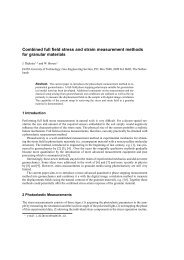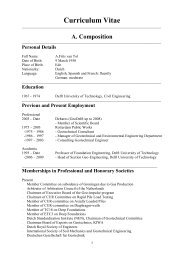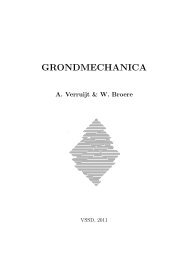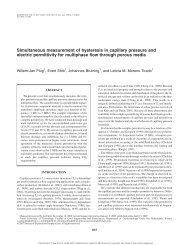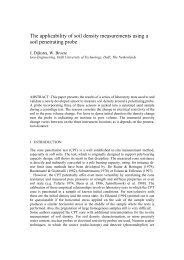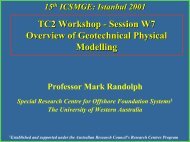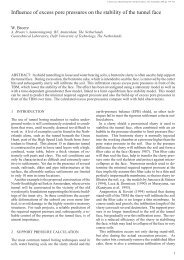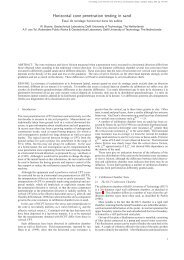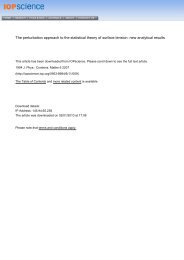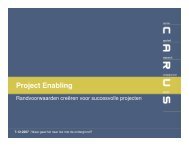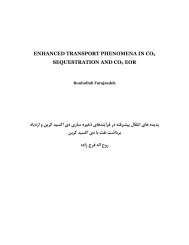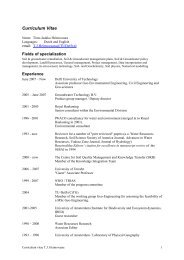Tunnel Face Stability & New CPT Applications - Geo-Engineering
Tunnel Face Stability & New CPT Applications - Geo-Engineering
Tunnel Face Stability & New CPT Applications - Geo-Engineering
Create successful ePaper yourself
Turn your PDF publications into a flip-book with our unique Google optimized e-Paper software.
140 3. Horizontal Cone Penetration TestingSand Type C 0 C 1 C 2 C 3Ticino 220 0.065 0.440 2.93Hokksund 165 0.140 0.400 3.38Table 3.7: Parameters for different sand types for use in 3.52, [87]this does not say that it is the only possible choice and it is certainly a somewhat arbitrary one,but the same could be said for other choices.In the same line of thought the vertical effective stress in V<strong>CPT</strong> theories could be replacedby the initial stress that acts in the direction of penetration in H<strong>CPT</strong>, which is the horizontaleffective stress. The idea is then to replace all instances of σh ′ in an existing V<strong>CPT</strong> theory byσ (0) and all instances of σ v ′ by σ h ′ , while keeping all other parameters unchanged. Best suitedwould of course be a theory that separately contains both stresses.A suitable candidate is the empirical relation given by Jamiolkowski [87] based on calibrationchamber tests on different sandsq V c = C 0 σ C 1v σ C 2h exp(C 3D r ) (3.52)with parameters for different sands given in table 3.7. This theory explicitly contains both initialstresses and has been derived for dry sands, so that the total stresses are equal to the effectivestresses.The relation for the horizontal sounding, derived from (3.52) according to the schemesketched above, isq H c = C 0 σ C 1h σ (0)C2 exp(C 3 D r ) (3.53)resulting in a ratio of horizontal over vertical cone resistanceq H/Vc = K C 1[ ] 1 + K C2(3.54)2KFor the parameters given in table 3.7 the resulting ratio of horizontal over vertical cone resistanceis sketched in figure 3.39 and compared with the result from (3.51). It shows the same trend ofhigher horizontal than vertical cone resistance at low K-values, only less strongly. For exampleat K = 0.5 the horizontal cone resistance is 50% greater than the vertical according to (3.51),but no more than 15% according to (3.54).The same approximation of the stress state can of course be applied to other theories. Thiswould lead to slight changes in the numerical results, but not to a fundamentally differentbehaviour, as this is mostly determined by the assumptions made in equating σh ′ in verticalpenetration with σ (0) in horizontal penetration. The conclusion already drawn in the previoussection that horizontal cone resistance is expected to be higher than vertical cone resistancewould remain unchanged.3.7 ConclusionsThe cone penetration test is highly suited for the in-situ determination of the soil characteristicsin soft soils. The interpretation of soil characteristics based on the test’s main results, the coneresistance q c and sleeve friction f s measurements, leans strongly on empirical relations. A



